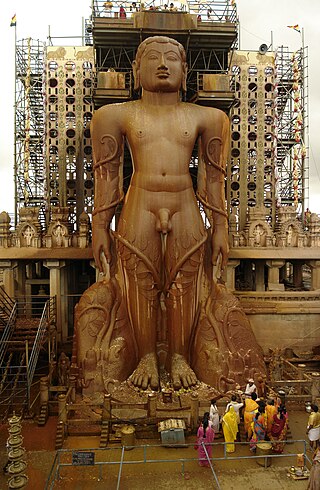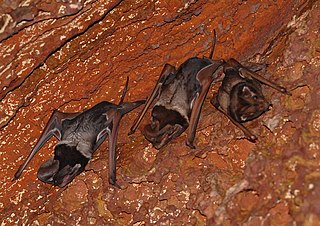
The Western Ghats, also known as the Sahyadri mountain range, is a mountain range that covers an area of 160,000 km2 (62,000 sq mi) in a stretch of 1,600 km (990 mi) parallel to the western coast of the Indian peninsula, traversing the states of Gujarat, Maharashtra, Goa, Karnataka, Kerala and Tamil Nadu. It is a UNESCO World Heritage Site and one of the 36 biodiversity hotspots in the world. It is sometimes called the Great Escarpment of India. It contains a very large proportion of the country's flora and fauna, many of which are endemic to this region. The Western Ghats are older than the Himalayas. They influence Indian monsoon weather patterns by intercepting the rain-laden monsoon winds that sweep in from the south-west during late summer. The range runs north to south along the western edge of the Deccan Plateau and separates the plateau from a narrow coastal plain called the Western Coastal Plains along the Arabian Sea. A total of 39 areas in the Western Ghats, including national parks, wildlife sanctuaries and reserve forests, were designated as world heritage sites in 2012 – twenty of them in Kerala, ten in Karnataka, six in Tamil Nadu and four in Maharashtra.

The Mandovi or Mahadayi, formerly known as the Rio de Goa, is a river described as the lifeline of the Indian state of Goa. The Mandovi and the Zuari are the two principal rivers in the state of Goa. The Mandovi joins with the Zuari at a common creek at Cabo Aguada, forming the Mormugao harbour. Panaji, the state capital and Old Goa, the former capital of Goa, are both situated on the left bank of the Mandovi.

Sharavati is a river which originates and flows entirely within the state of Karnataka in India. It is one of the few westward flowing rivers of India and a major part of the river basin lies in the Western Ghats. The famous Jog Falls, located about 25 km from Siddapura, is formed by this river. The river itself and the regions around it are rich in biodiversity and are home to many rare species of flora and fauna.

Agumbe is a village situated in the Thirthahalli taluka of Shivamogga district, Karnataka, India. It is nestled in the thickly forested Malenadu region of the Western Ghats mountain range. Owing to its high rainfall, it has received the epithet of "The Cherrapunji of South India", after Cherrapunji, one of the rainiest places in India.

Gokak is a taluka headquarters in the Belagavi district of Karnataka state, India. It is located around 70 km from Belagavi at the confluence of two rivers, the Ghataprabha and the Markandeya. The population of the city is according to 2011 census is 79,121. Gokak city has second highest GDP in the district of Belagavi after Belagavi city. The common language is Kannada.

Dudhsagar Falls is a four-tiered waterfall on the Mandovi River in the Indian state of Goa. It is 60 km from Panaji by road and is located on the Belgaum–Vasco Da Gama rail route about 46 km east of Madgaon and 80 km south of Belgaum. Dudhsagar Falls is amongst India's tallest waterfalls with a height of 310 m (1017 feet) and an average width of 30 metres (100 feet).

Karnataka, the sixth largest state in India, has been ranked as the third most popular state in the country for tourism in 2014. It is home to 507 of the 3600 centrally protected monuments in India, second only to Uttar Pradesh. The State Directorate of Archaeology and Museums protects an additional 752 monuments and another 25,000 monuments are yet to receive protection.

The Indian State of Karnataka is located between 11°30' North and 18°30' North latitudes and between 74° East and 78°30' East longitude.It is situated on a tableland where the Western Ghats and Eastern Ghats converge into the complex, in the western part of the Deccan Peninsular region of India. The State is bounded by Maharashtra and Goa States in the north and northwest; by the Lakshadweep Sea in the west; by Kerala in the south-west and Tamil Nadu in the south and south-east, Andhra Pradesh in the south-east and east and Telangana in the north-east. Karnataka extends to about 850 km (530 mi) from north to south and about 450 km (280 mi) from east to west.
Chandgad is a Small city and tehsil headquarters of chandgad taluka, of Kolhapur district that is in the Indian state of Maharashtra.

Wroughton's free-tailed bat is a free-tailed bat formerly considered to be confined to the Western Ghats area of India, though it has also recently been discovered in northeast India and in a remote part of Cambodia. It is classified as a Data Deficient species as little is known about their habitat, ecology, or foraging range.
Jugul is a village in the southern state of Karnataka, India. It is located in the Athani taluk of Belagavi district in Karnataka.
Vajrapoha Falls is a waterfall in the Belgaum district of Karnataka in India. It is situated in a mountainous forest 8.5 kilometres (5.3 mi) in south west direction from the village of Jamboti. Between the village of Gavali and Chapoli on an elevated hillock, the Mandovi River that flows to the beautiful Vajrapoha Falls that fall for up to 200 metres (660 ft) and are best seen after the monsoon season (June–October). The falls are about 1.5 hours southwest of Belgaum.

Bhimgad Wildlife Sanctuary is a protected area in the Western Ghats, in Khanapur Taluk of Belgavi District near Jamboti Village, Karnataka state, India. This 19,042.58 ha (73.5238 sq mi) of Tropical and subtropical moist broadleaf forests forest area was long awaiting to be a wild life sanctuary and finally declared in December 2011.
Talawade is a village in Belgaum district of Karnataka, India. The Mandovi River is fed by streams near the village.

The Koyna Hydroelectric Project is the second largest hydroelectric power plant in India, just after the Tehri Dam Project. It is a complex project with four dams including the largest dam on the Koyna River, Maharashtra, hence the name Koyna Hydroelectric Project. The project site is in Satara district.

The Mhadei Wildlife Sanctuary is a 208.5-km2 (80.5-mi2) protected area in the Indian state of Goa in the Western Ghats of South India. It is located in the North Goa District, Sattari taluka near the town of Valpoi. The sanctuary is an area of high biodiversity, and is being considered to become a Project Tiger tiger reserve because of the presence of Bengal tigers.
Bhimgad Fort are historical ruins located within the Bhimgad Wildlife Sanctuary, on a detached spur of the Western Ghats, in Khanapur Taluk of Belgaum District near Jamboti Village, Karnataka state, India. It is located in the heart of the Mhadei river watershed. It was built and occupied by Shivaji in the mid 17th century during his conquest of South India to defend from the Portuguese colonial troops who controlled Goa at that time.
Masthikatte is a village located in Hosanagara Taluk, Shimoga district, Karnataka, India.pincode 577425
The Mahadayi Water Disputes Tribunal (MWDT), also referred to as the Mhadei Water Disputes Tribunal, is a tribunal that adjudicates the dispute over River Mhadei water allocation.











